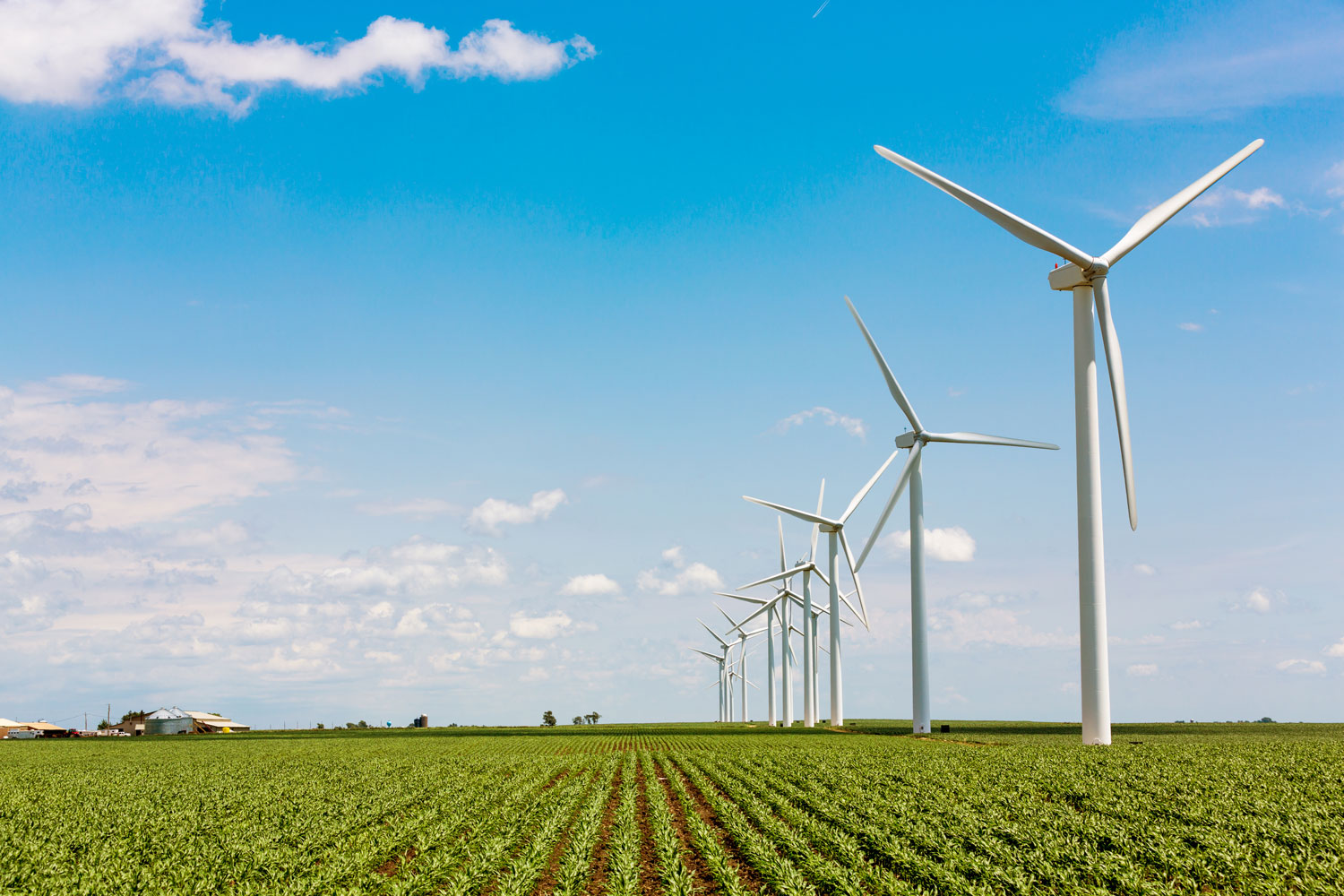As seen in the Tried & True Spring 2022 issue
The cost to power businesses is constantly shifting. No matter the industry, efficient operations minimize rising energy costs. That’s why cost-effective alternatives are becoming more of the norm to conserve and invest in renewable energy, and farming is no exception.
POWERING AG
Farms are not only direct energy consumers—gasoline, diesel, electricity and natural gas—they also adopt indirect methods—fertilizer and pesticides—that act as intensive energy inputs to produce crops. Additionally, some farmers lease lots of their land as hubs for wind turbines, oil drilling or gas lines that create energy resources in their communities. For the agribusiness sector focused on crop and animal production, reducing a farm’s external energy outputs can help them find self-reliance and sustainability.
At first, it may seem that investing in biomass, geothermal, solar, water and wind power is expensive and structurally unobtainable. However, now that more ag operations embrace a greener way of growing, the cost is not as it once was. Ag Tech purchases and planning phases to execute can be as gentle on the wallet as one’s timeline or reserves requires. Whether you’re interested in adding one facet or a complete power investment overhaul, renewable energy can sustain your agribusinesses with a bit of help from Mother Nature.
BIOMASS ENERGY originates from various sources, including plants and organic waste. Biomass fuel powers farms from repurposed crop residue and manure to crops grown for energy usage. The sugars and oils derived from plant and animal materials power vehicles (biofuel or biodiesel) and provide heat and electricity (biopower). Farm science researchers are big believers in biomass energy. Some believe that as much as $20 billion in new income for farmers and rural communities is ripe for taking in this sector. Moving toward this source can also reduce global warming emissions at the same rate as if we removed 70 million cars from running on the roads. Those are big numbers, and legions of agribusinesses invest and bank on it.
However, there is some controversy about growing fuel rather than food to meet today’s global needs. While some farmers choose one avenue of production over the other, many grow dual-purpose crops. Canola, crambe and sunflower are harvested as fuel and livestock feed. There are some drawbacks for those who grow biomass-dedicated corn—the most widely harvested biofuel crop. That’s why alternative native prairie grasses, like switchfoot, and fast-growing poplar and willow trees, are making a biomass energy surge. These perennial, low-maintenance crops are easy to grow, a cinch to harvest and, overall, less expensive from seed to market. They are more sustainable production-wise than corn—something to consider if you’re thinking about making the switch before you choose your crop.
GEOTHERMAL ENERGY is a climate- friendly power-source alternative that harnesses the power of the earth to control temperatures and create electricity. Not only do geothermal pumps heat or cool homes and commercial buildings, but they also provide hot water. The infrastructure can be sized to the heating and cooling demands of any building type. The going-green benefits of harnessing the sun’s heat stored in the ground include a cleaner environment, reducing carbon emissions and slashing the dependence on fossil fuels.
Geothermal energy can require significant upfront costs and infrastructure changes. Excavation, drilling, installing ground loops and powering up the system controls are investments that will quickly show a return compared to other systems. Although the recovery of money may not be as fast with typical HVAC systems, this earth-sourced energy cost is usually recouped within 4 to 7 years, qualifies for federal, state and utility rebates and provides a green power source that can cut energy consumption by half.
SOLAR POWER utilizes passive energy from the sun and converts it to daily operational energy. The cost of solar has declined over the years, and with rebates and tax breaks for energy efficiency, more people have invested in systems across the country. The business of agrivoltaics—installing solar panels on farmland—has been found to improve energy efficiency and gains in productivity. The sun’s benefits also include reduced electricity costs, the potential to extend growing seasons and marketing to consumers who are sustainability-minded when sourcing products they want to use.
Did you know you can plant crops under solar panels? Fueling plant growth while renewing energy means generating power while also providing shade for crops. That means carrots, kale, garlic, beets, radishes, some types of lettuces and other plants will thrive due to less direct sunlight. Plants growing in the shade also require less water. Vegetables and herbs grown under the panels create condensation, or “sweat.” This moisture is good for the plants and has been found to keep solar panels cooler as they work. The heat and water stress are minimal on these shaded plants, and the bountiful harvest growers are reaping show productive results.
WATER POWER energy is captured from the force of falling, flowing
or fast-moving water. It uses the elevation difference created by a dam or diversion structure of water flowing into one side then out at a lower level on the on the other side. Water power, commonly known as hydropower, is one of the oldest and most significant sources of power. It accounts for close to 37% of all US renewable power generation and 7% of our country’s electricity source.
In addition to being cost-effective and super-clean, one of the perks of hydropower is that it sends energy to the power grid immediately. It’s a flexible and highly reliable source of secondary power too. Flood control, irrigation and water supply are all benefits of investing in hydropower, which works in tandem with Fratco pipe’s drainage solutions. By driving water where you want it now and creating water stores for later, hydropower’s lifespan is reliable and cost-effective.
WIND POWER is a time-tested mode for farms to generate electricity and pump water. Working with nature is an everyday occurrence, and that’s why small-scale wind turbines are the perfect on-site energy addition. They also make a great alternative, or complement, to solar energy. Wind power can also be an offering that farmers happily add to their product portfolio. Wind creates income and clean energy, and it can also reenergize small towns hungry for an economic boost.
Many growers have access to the acreage needed to harness the wind in mass form. Energy companies typically provide a landowner with 30-to-40-year leases. Farmers that host wind turbines can earn $3,000 to $7,000 yearly for leasing an area of land equal to a two-car garage. In 2019, farm bankruptcy rates reached 20%. This opportunity is a payday that can make up for times of drought, fluctuating crop or commodity prices and economic dips. The more turbines leased and installed on land, the bigger the yearly check. One study found that landowners with wind turbines invested twice as much money into home improvements, outbuildings and equipment versus landowners without windfarms. That extra income can make all the difference in an agribusiness barely surviving or genuinely thriving.
Managing Your Energy Options
UNDERSTAND YOUR POWER USAGE
- Invest in an energy assessment to calculate energy output and highlight areas for improvement.
- Fine-tooth comb your energy bills. Know where your energy is going and how much you’re spending.
- Explore the areas of your farm that are deep consumers of energy. Are there ways to streamline and cut out inefficiencies?
YOUR NEXT MOVES
- Find areas of energy flexibility. Shifting some tasks to off-peak time usage can significantly reduce costs.
- Energy efficiency should become a factor in all decision-making, whether hiring more employees, upgrading equipment or making infrastructure changes. Navigating these choices with power needs in mind fuels your farm and your bottom line.
- Make three-, five- and ten-year plans detailing your farm’s shift to become less reliable on non-renewable means of power. If you install Fratco pipe on the last section of your acreage this year, begin to sketch out the cost and benefits of adding more solar-based equipment in the next two or three years. The difference repurposing water and harnessing the sun’s power can make in ag self-sufficiency is enormous, and the environment will also thank you.
- Create and stick to a maintenance schedule for equipment, machinery and vehicles. Be proactive by looking for issues before they become problems to keep your business functioning in top form.
NOW, GAIN EFFICIENCY
- Move from conventional to minimum tillage. This act alone can save farmers close to 10% on fuel costs: every dollar matters.
- Insulate all outbuildings and ensure cooling and refrigeration units are in working order. When it’s time to repaint, reach for light-hued, heat-reflective colors for roofs, ceilings and walls.
- Maximize natural light and ventilation in offices, barns and other buildings when possible.
- Consider investing in split heating and cooling systems. Solar power combined with other energy-efficient systems makes perfect partners in summer and winter months.
- Use energy-saving lightbulbs and motion sensors in tandem to keep costs low and lights off when they’re not needed.
- Investing in solar power, wind, ground-sourced heat pumps and water drainage solutions helps with energy needs now and in the long run.
Today, 30% of the world’s available energy is dedicated to growing food. That includes producing crops, livestock, fishing, forestry products, food storage, processing, transportation and food preparation. Fossil fuels are finite. Investing in renewable resources widens access to efficient, clean energy while producing better- quality food. Being good stewards of our planet’s resources is a motivator for the team at Fratco. A climate- friendly, food-secure world for all is obtainable when we work together for a greener tomorrow.
Sources: USDA, Farm Progress, Office of Energy Efficiency & Renewable Energy, Wired, Sustainable Agriculture Research and Education, and World Resources Institute




